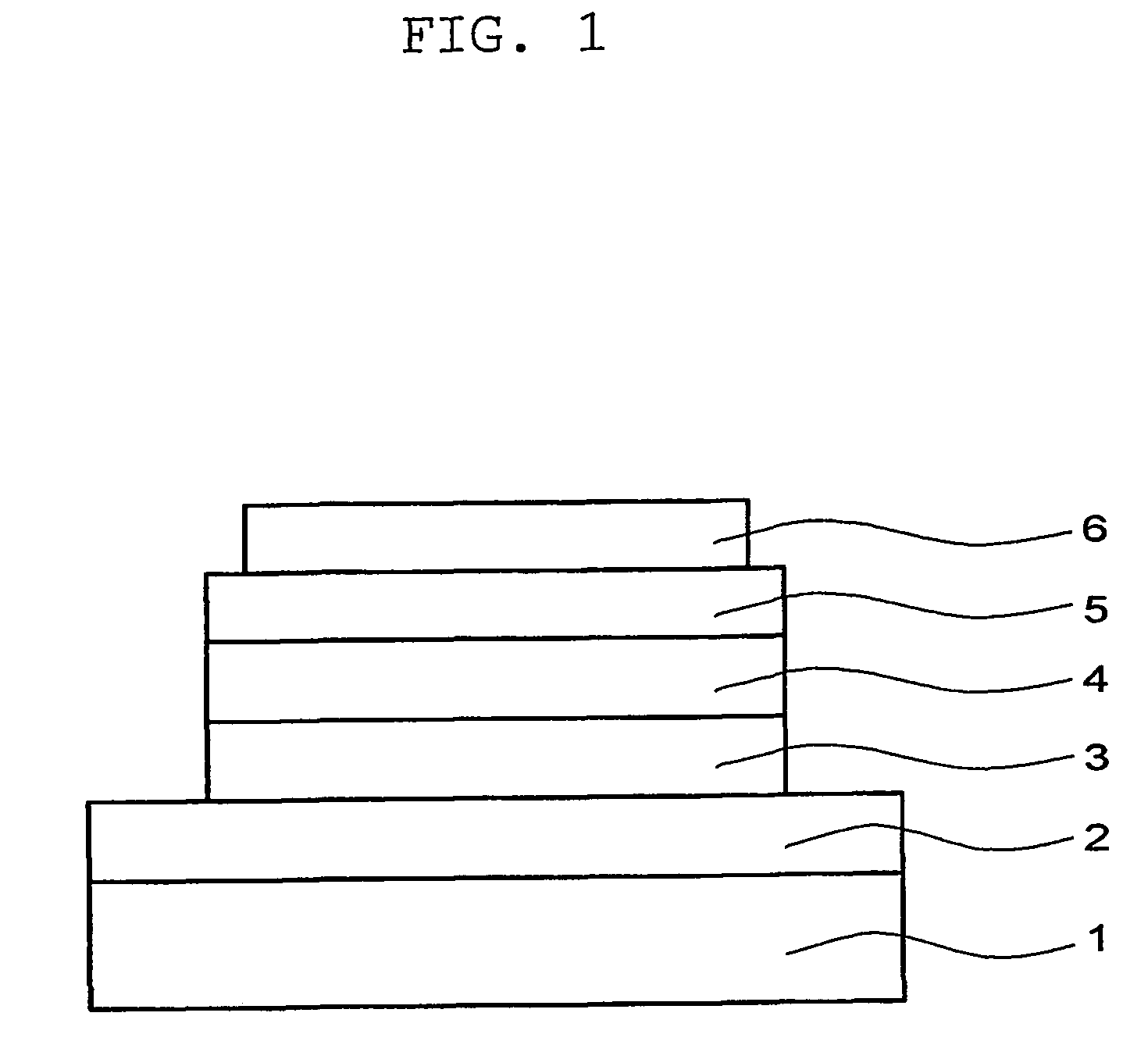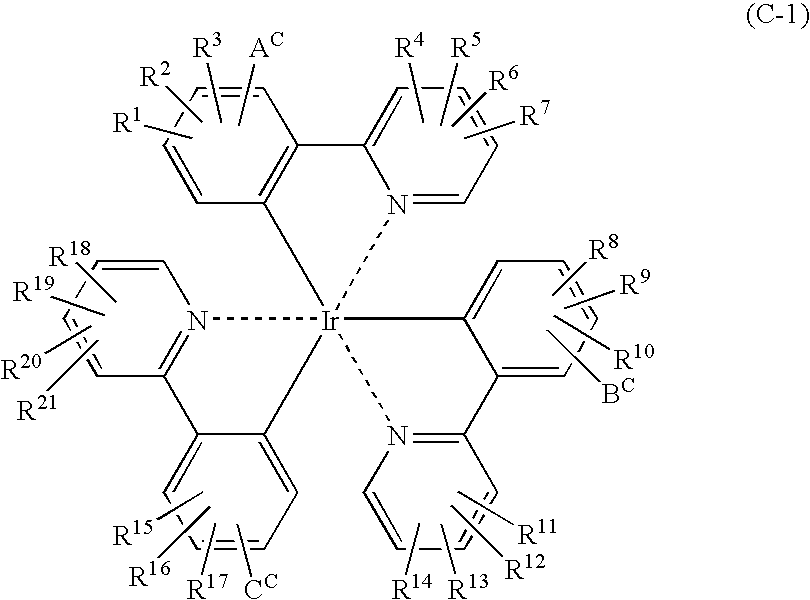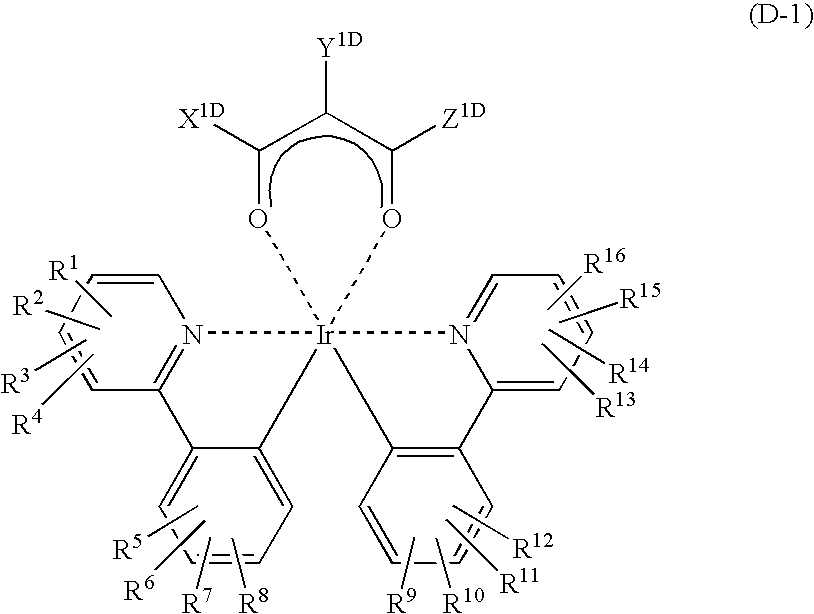Light emitting material and organic light-emitting device
a light-emitting device and light-emitting material technology, applied in the direction of solid-state devices, discharge tubes/lamp details, natural mineral layered products, etc., can solve the problems of low light emission efficiency, difficult selection of materials that meet the specification of displays, and demerit in the production process of organic light-emitting devices, etc., to achieve small energy loss, improve the durability of the device, and high light emission efficiency
- Summary
- Abstract
- Description
- Claims
- Application Information
AI Technical Summary
Benefits of technology
Problems solved by technology
Method used
Image
Examples
example 1
Synthesis of Polymerizable Compound Ir(3-MA—PPy)(3-PrCO—PPy)2
(1) 2-(3-Methoxyphenyl)pyridine (3-MeO—PPy) was synthesized by a conventional method.
[0309]That is, as shown in the reaction scheme below, (3-methoxyphenyl)magnesium bromide was synthesized from 22.4 g (120 mmol) of 3-bromoanisole with 3.4 g of magnesium in dry tetra hydrofuran (THF) in an argon stream by a conventional manner. This was slowly added to a dry THF solution of 15.8 g (100 mmol) of 2-bromopyridine and 1.8 g of (1,2-bis(diphenylphosphino)-ethane)dichloronickel (II) (Ni(dppe)Cl2) and the mixture was stirred at 50° C. for 1 hour. After adding 250 ml of 5% hydrochloric acid aqueous solution to the reaction mixture, the reaction mixture was extracted with chloroform to obtain a target substance and the organic layer was distilled under reduced pressure. 17.4 g (93.9 mmol) of 2-(3-methoxyphenyl)pyridine (3-MeO—PPy) was obtained as a color less transparent liquid. Identification was performed by CHN elementary analy...
example 2
Synthesis of Ir(3-MA-PPy)(3-PrCO—PPy)2 polymer
[0326]In a reactor were charged 2.22 g (2.5 mmol) of Ir(3-MA—PPy)(3-PrCO—PPy)2 complex synthesized in Example 1, 0.010 g (0.061 mmol) of 2,2′-azobis(isobutyronitrile) (AIBN), and 30 ml of butyl acetate and the atmosphere was exchanged with nitrogen. Thereafter, the mixture was allowed to react at 80° C. for 10 hours (cf. Reaction Scheme below). After completion of the reaction, the reaction mixture was dripped into acetone to perform reprecipitation and the resultant polymer was recovered by filtration. A procedure of reprecipitation by dripping a chloroform solution of the recovered polymer into methanol was further repeated 2 times to purify the polymer, which was then recovered and dried in vacuum to afford 1.85 g of the objective Ir(3-MA-PPy) (3-PrCO—PPy) 2 polymer as powder. The elementary analysis of C, H, N and Ir of the obtained polymer indicated that the polymer had the same composition as Ir (3-MA-PPy) (3-PrCO—PPy)2. The weight...
example 3
Synthesis of Polymerizable Compound Ir(3-MOI-PPy)(3-PrCO—PPy)2
[0328]A monomer intermediate Ir(3-HO—PPy)3 synthesized in the same manner as in Example 1 was allowed to react with 2-methacryloyloxyethyl isocyanate (Trade name “Karenz MOI”, manufactured by Showa Denko K. K., herein after sometimes referred to as “MOI”) in a ratio of 1:1 (molar ratio) and then the remaining hydroxyl groups were allowed to react with PrCOCl to obtain a complex composed mainly of Ir(3-MOI-PPy) (3-PrCO—PPy)2.
[0329]That is, in a reactor were charged 32 ml of dry THF, 2.81 g (4 mmol) of Ir(3-HO—PPy)3, and 0.636 g (4 mmol) of MOI, and after addition of a catalyst amount of dibutyltin (IV) dilaurate, the mixture was allowed to react at 20° C. for 5 hours. To this reaction mixture was added 2.400 g (24.5 mmol) of triethylamine as a base. Thereafter, a solution of 1.48 g (16 mmol) of propionyl chloride in 16 ml of dry THF was dripped over 30 minutes, followed by reaction at 20° C. for 5 hours to react the remai...
PUM
| Property | Measurement | Unit |
|---|---|---|
| internal quantum efficiency | aaaaa | aaaaa |
| external quantum efficiency | aaaaa | aaaaa |
| external quantum efficiency | aaaaa | aaaaa |
Abstract
Description
Claims
Application Information
 Login to View More
Login to View More - R&D
- Intellectual Property
- Life Sciences
- Materials
- Tech Scout
- Unparalleled Data Quality
- Higher Quality Content
- 60% Fewer Hallucinations
Browse by: Latest US Patents, China's latest patents, Technical Efficacy Thesaurus, Application Domain, Technology Topic, Popular Technical Reports.
© 2025 PatSnap. All rights reserved.Legal|Privacy policy|Modern Slavery Act Transparency Statement|Sitemap|About US| Contact US: help@patsnap.com



